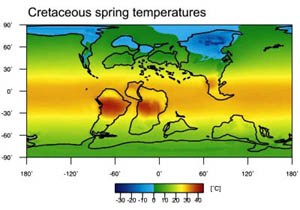Looking at prehistoric climatic change may provide new insights into predicted near-future climate. New results for a greenhouse effect that occurred during the late Cretaceous some 75-90 million years ago suggest that very different mechanisms controlled the climate then and that these may be applicable in the near future, perhaps forcing a revision of received wisdom regarding climate change.
Sascha Floegel and colleagues at the IFM-GEOMAR in Kiel, Germany, working with Thomas Wagner of the University of Newcastle upon Tyne, England, have investigated the causal relationships and feedback loops between the tropics and higher latitudes and have identified a climate kitchen in a world with an average global temperature between five and nine degree Celsius higher than today. For comparison, a six degree Celsius increase in global temperature by 2050 is within the upper range of current IPCC (Intergovernmental Panel on Climate Change) climate scenarios, Wagner told Spotlight.

Thomas Wagner
Climate modelling is a key technique used to help us explain the large-scale mechanisms locked in geological evidence. The researchers have used marine geological records and data from global palaeoclimate simulations to identify what they describe as a previously unrecognized link between higher latitude climate dynamics and tropical African climate. The latter, they explain, led to an exceptionally high burial rate of organic carbon in the deep tropical Atlantic Ocean. Previous research into the marine geological record showed that this enhanced carbon burial in the deep ocean occurred over relatively short periods of just 5000 years but re-occurred over millions of years in a regular pattern.
The researchers plugged in different values for how the Earth’s axis changes over time, like a gyroscope precessing, into their model to compensate for the effects of precession on climate and allow them to see the underlying mechanisms affecting the climate during past periods when greenhouse conditions were operating. They found that the amount of energy approaching the top of the atmosphere, so-called insolation, which triggered cyclic variations in the water cycle in tropical Africa, was found to coincide with massive burial of organic carbon at the sea floor. This suggests that processes in the atmosphere drive changes in the ocean.

Sascha Floegel
The details of these new results challenge current notions on the role of the tropics as a main driver of Cretaceous climate. Instead, they support the conclusion that tropical climate in a greenhouse world is ultimately triggered by climate change at mid-southern latitudes, with precipitation and river discharge being the transport mechanisms.

Model Greenhouse (Credit: Floegel and Wagner)
So, how might these prehistoric results shed light on today’s and even more importantly predicted near-future climate. Today, the tropics control a big fraction of Earth’s climate. The new findings suggest that as global carbon dioxide levels rise, the mid-latitudes will have a much stronger impact on the low latitude climate system. This could have severe consequences for the water cycle at such low latitudes and the associated nutrient and carbon fluxes to coastal areas. Moreover, the additional complications this study throws into the climate mix, reveals that there are still gaps to be filled in our models of future climate change, and specifically global warming.
Further reading
Palaeogeog, Palaeoclimatol, Palaeoecol, 2006, 235, 288;
http://dx.doi.org/10.1016/j.palaeo.2005.09.034
Nature, 2005, 437, 241
http://dx.doi.org/10.1038/nature03976
Thomas Wagner
http://www.ceg.ncl.ac.uk/profiles2/ntw14
Suggested searches
climate change
climate modelling